Ascending to the throne at the age of 7
The king named Duy Tan, also known as Nguyen Phuc Vinh San, was born on August 26, Canh Ty year (equivalent to September 19, 1900) and took his last breath on December 26, 1945. He was the son of King Thanh Thai and Queen Nguyen Thi Dinh. Duy Tan, along with his father King Thanh Thai and King Ham Nghi, were three famous kings in the history of Vietnam during the French colonial period because of their deep patriotism. They constantly strived to find ways to restore independence and autonomy to the country, the Vietnamese people.
When King Thanh Thai was forced to abdicate the throne due to health reasons and was exiled in Vung Tau, the French colonialists and the Nguyen dynasty discussed the selection of the successor. To appease the public and patriotic intellectuals, the French Diplomatic Institute, under the leadership of Levecque, had to choose the son of King Thanh Thai to inherit the throne.
King Thanh Thai had many sons, and according to the rule, the successor had to be the eldest son. However, the French did not follow this rule. The French Diplomatic Institute proposed that the French Secret Institute bring the princes of King Thanh Thai to choose a successor. All the princes were present except for the youngest prince Vinh San. At that time, Vinh San was only 7 years old and was hiding under the bed catching grasshoppers, causing people to search for him in chaos.
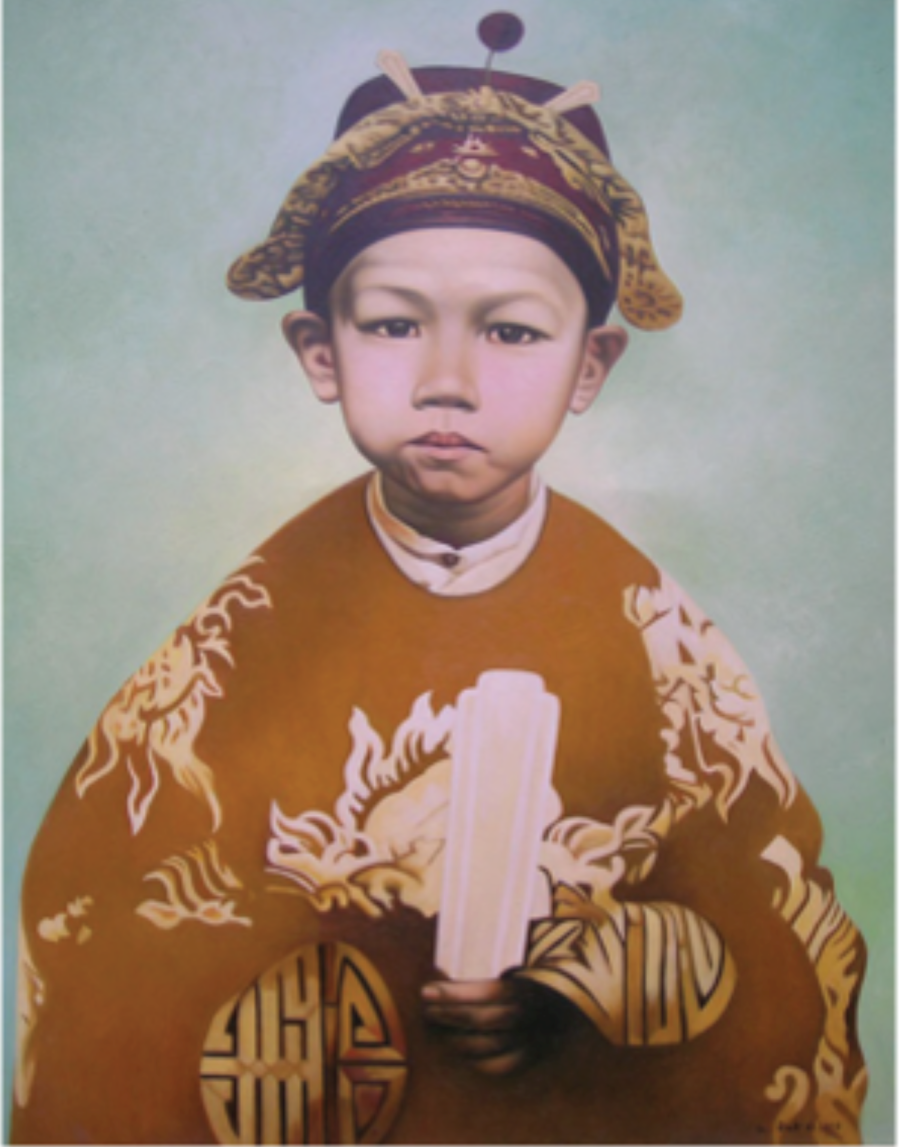
King Duy Tan, real name Nguyen Phuc Vinh San
The French saw Vinh San, a young boy, appearing shy and scared in front of Westerners, and they were very pleased with this, so they chose him to be enthroned. In the book “King Duy Tan” by author Hoang Hien, published in 1995, it was recorded that Vinh San’s siblings were eliminated for several reasons, the most important of which was “the heirs all had the bad traits of their father (King Thanh Thai), with unattractive faces, ungraceful limbs, and sinister expressions.” The French’s plan was to put a young king who knew nothing about governing the country, had no spirit of resistance against the French, so that it would be easy to manipulate him in the future. They believed that the younger the age, the easier to control.
On July 28, Dinh Mui year (1907), prince Nguyen Phuc Vinh San, who was only 7 years old (although historical records usually state 8 years old because the court requested to increase the age), officially ascended to the throne. According to the book “Stories of Nguyen Dynasty Kings”, at that time, the set of clothes for the young king had not been completed. Vinh San had to wear the royal robe of his father King Thanh Thai, a robe that weighed 5kg. When wearing this heavy robe, the young king could not move and had to sit in one place.
Diligently studying to… resist France
Vinh San, a young king who seemed weak and naive, completely changed after the coronation ceremony in just one day. Without any fear of Westerners, he appeared steadfast and confident in every word, bearing the mark of a true king. When interacting with the Resident General of Indochina and the Resident of Central Vietnam, Vinh San directly communicated in French without hesitation.
When it came time to choose an era name, Vinh San chose “Duy Tan,” a term that means reform or innovation. This created a strong challenge for the French, as they always wanted the people of Annam to remain backward in order to easily dominate them. But Vinh San, upon ascending the throne, chose the two words “Duy Tan” to clearly express his will and determination.
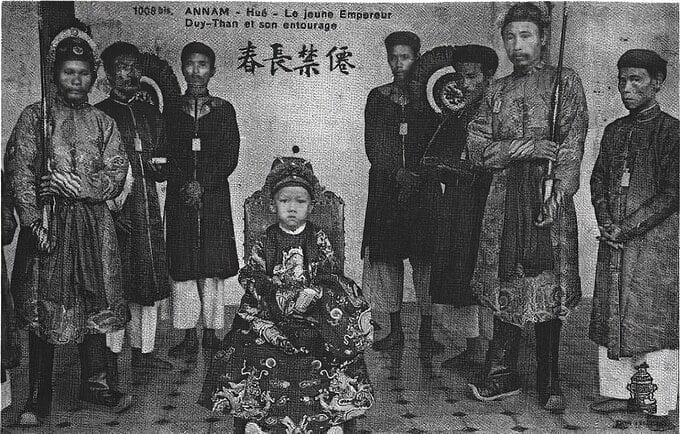
Vinh San, after ascending to the throne, chose Duy Tan as the era name
A journalist reported the coronation ceremony, not foreseeing the future acts of resistance against France by King Duy Tan. However, he realized the mistake of the French colonialists in choosing Vinh San as the king of Southern Vietnam. His article ended with a French sentence, which means, “Only one day on the golden throne completely changes the appearance of a boy just turning eight years old.”
When he ascended the throne, Duy Tan was provided with an environment of entertainment to distract him from national affairs. However, Duy Tan did not indulge himself in endless pleasures. Instead, he spent his time learning and studying various fields such as French language, philosophy, political science, law, and court affairs.
He also mastered many musical instruments such as moon lute, zither, and absorbed Western cultural knowledge and achievements. Dr. Eberhard, who taught him French, philosophy, and political science, often told those around him, “This young emperor will become an extraordinary person.”
As he grew older, King Duy Tan increasingly showed his determination to oppose France through his words and actions. In the book “Nearly 400 years of Nguyen Dynasty Kings”, it is recorded that every year, the king and queen mother would go to Thuan An for vacation. On sunny days, the king would go to the beach to swim and then play the game of building sand castles.
One time, after completing the construction of a fortress, a guard officer brought a basin of water for the king to wash his hands. King Duy Tan pointed to the fortress and asked the guard officer, “If the hands are dirty, what do we use water to wash? But if the water is dirty, what do we use to wash?” The guard officer understood the king’s meaning but dared not express it, only hesitated. King Duy Tan then said, “If the water is dirty, we can only use blood to wash it clean.”
One time, Minister Nguyen Huu Bai invited King Duy Tan to go fishing for entertainment. While waiting for the fish to bite, King Duy Tan’s fishing line unexpectedly got stuck on an unknown object. Seizing this opportunity, King Duy Tan made a profound couplet: “Sitting on water cannot prevent water. Once you drop the line, you must search.” This couplet means: “Even though I am sitting on a golden throne, I cannot prevent the country from falling into the hands of the French. If I have become the king, I must find a way to rescue the nation and the country.”
Nguyen Huu Bai, deeply grateful for the king’s sincere sentiments, but seeing that he himself was facing insurmountable difficulties, expressed his thoughts in a couplet: “Reflecting on life makes life tedious. It is better to close one’s eyes to all things.” Upon hearing this, King Duy Tan felt extremely sad.
At that time, the Vietnamese Restoration League, founded by Phan Boi Chau in 1912, was conducting activities to resist the French with strong determination. Recognizing the independence and self-reliance aspirations of King Duy Tan, the Vietnamese Restoration League sought to leverage the king’s support to enhance the effectiveness of the resistance against the French.
The Vietnamese Restoration League cleverly exploited a strategy: they compelled the driver of King Duy Tan to resign and then introduced a member of the organization to that position. As a result, they had the chance to present a letter to the king, speaking about the difficulties that the people were enduring and criticizing the crimes committed by the French. The letter also demonstrated the unwavering commitment of the organization: they would stand up to expel the invaders. In the letter, there is an impressive passage: “The United States, a country of black skinned people, after 50 years, can still be strong, let alone us, the descendants of the Dragon Lord, 25 million people, how can we be weak? Heaven has given birth to an intelligent, upright king with the desire to send soldiers to resist the French. The land has given birth to talented people who have the right to expel invaders and protect the people!”
After reading the letter, King Duy Tan felt deeply moved. He organized a secret meeting with two leaders of the Vietnamese Restoration League, Thai Phien and Tran Cao Van. Both sides discussed the domestic and international situation and reached a consensus on the uprising plan.
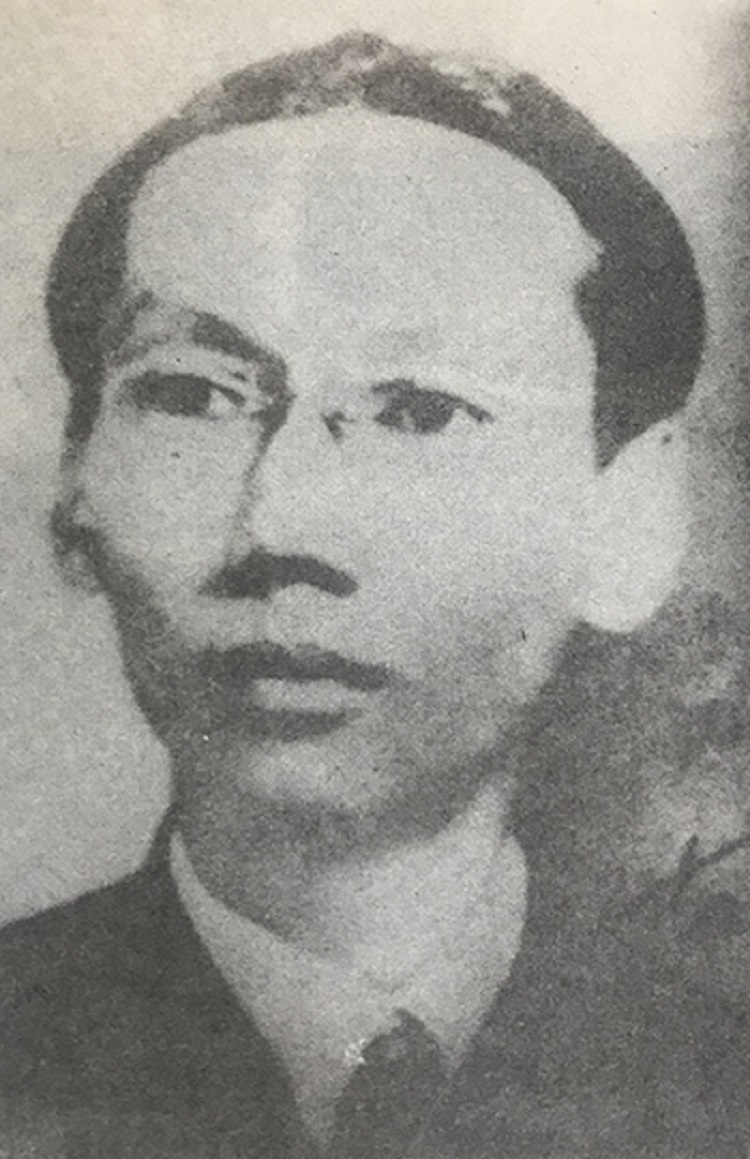
King Duy Tan constantly studied and acquired knowledge
On May 3, 1916, the struggle against French domination initiated by King Duy Tan and the Vietnamese Restoration League officially began. The main force in this uprising was mainly Vietnamese soldiers who had been gathered by the French in Hue with the intention of sending them to France to participate in the battles between France and Germany as mercenaries, along with inexperienced soldiers in the capital.
In the dark sky on the night of May 2, the young king Duy Tan quietly left the Imperial Palace. He wore a dark red dress, a black scarf on his head, and fabric pants, heading to the meeting point at Phu Van Lau. A small boat took him along the Bach Ho River, then against the flow of the Loi Nong River to reach a quiet house on the riverbank.
Unfortunately, two days earlier, a member of the uprising had revealed information about this plan. On the afternoon of May 2, the French colonialists ordered the confiscation of all guns from the Vietnamese troops and prohibited any Vietnamese soldier from leaving the camp.
King Duy Tan, under the protection of two people, Tran Quang Sieu and Ton That De, went to Ha Trung village to wait for a signal of success from the revolutionary army. However, by 3 o’clock in the morning, there was no sign of progress. The revolutionary command realized that their plan had been discovered and hurriedly put King Duy Tan on a boat to escape to the mountains in the southwest. They tried to find a hiding place in Ngũ Tây hamlet, An Cựu village, Thua Thien Hue. However, all their efforts could not escape the surveillance of the French.
On the morning of May 6, King Duy Tan, along with two leaders Thai Phien and Tran Cao Van, and many other revolutionaries, were captured. The French Legation Court issued an order for the Secret Institute to conduct a quick and strong trial of those involved in the uprising, including the king. Ho Dac Trung, Minister of Education, was entrusted to draft the verdict.
In the silence of the dark cell, Tran Cao Van received the sad news. He knew that Ho Dac Trung, a loyal person, was involuntarily involved in this matter. Therefore, Tran Cao Van tried to suggest to Ho Dac Trung: accuse the revolutionaries to reduce the punishment for the king. Ho Dac Trung followed this advice.
When the verdict was drafted, Tran Cao Van, Thai Phien, Ton That De, and Nguyen Quang Sieu were all sentenced to death. Meanwhile, the king, a young and inexperienced person, was considered to have been dragged into the revolutionary army, so he was not convicted.
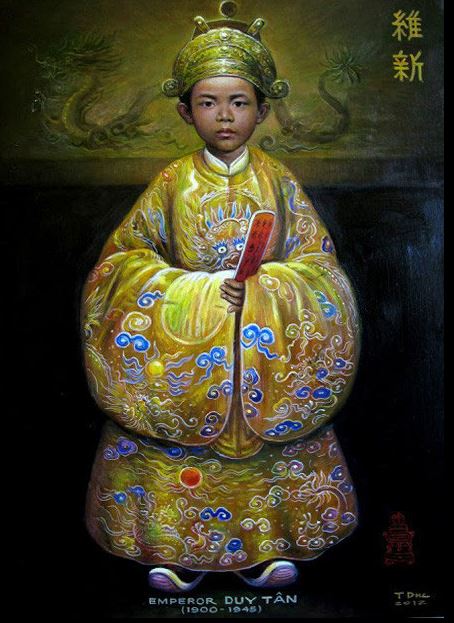
On May 6, 1916, King Duy Tan was arrested
Months and days in harsh exile and a sudden death
Although not convicted, King Duy Tan had to endure a period of exile after several refusals to compromise with the French military. In the book titled “King Duy Tan”, the young king expressed his love for the country through his words: “If I am not brave enough to lead that (referring to the 1916 uprising), in the eyes of the people, I would be seen as a coward, betraying the homeland, betraying the ancestors. The helplessness in fulfilling obligations, in protecting the homeland, in protecting the leadership of my people, truly does not befit the king that I have been given.” The fact that King Duy Tan was arrested, along with his courageous actions against the enemy, had a strong impact on public opinion at that time, not only in Vietnam but also in the Vietnamese community in France.
In early November 1916, the young king Duy Tan, along with King Thanh Thai, was exiled to Reunion Island in Africa. People who were allowed to accompany the king included Queen Nguyen Thi Dinh, Queen Mai Thi Vang, and the king’s younger sister Me Cuoi. However, due to their inability to adapt to the climate on the island, Queen Mai Thi Vang experienced a miscarriage and later became unable to have children. King Duy Tan advised her to return to the homeland to preserve her health. Finally, in 1921, Mai Thi Vang decided to return to Vietnam and live alone until the end of her life.
After a six-year period, King Duy Tan married a girl named Fernande Antier, who was the daughter of a French-origin family. They together had a princess named Rita Suzy Georges Vinh San and three princes named Guy Georges Vinh San, Yves Claude Vinh San, and Joseph Roger Vinh San.
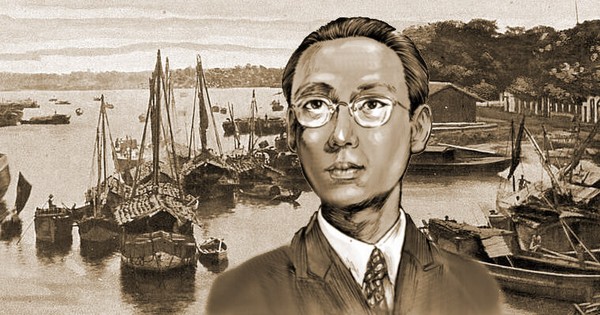
He went through years of arduous exile and died unexpectedly in a plane crash
In exile, King Duy Tan had to face difficult days. However, even in harsh conditions, he continued to study. In the isolation of the island, when there was no information about science or current events, the former king sought and researched about wireless telegraphy in order to create communication devices with the outside world. According to an article from Reunion Island, the former king became an expert, with the ability to “assemble a wireless machine as well as read a speech in an excellent language to present the principles of the science he loved,” despite the lack of equipment and resources.
During his exile, King Duy Tan often wanted to join the French military, but he was always rejected because people suspected he could bribe and conspire to leave the island to restore the monarchy. When World War II broke out, France faced Nazi Germany. General De Gaulle called for resistance. King Duy Tan decided to join the military, and in 1945, he was promoted to the rank of Major. Later, De Gaulle supported the former king’s return to Vietnam to participate in political affairs.
Before returning to his homeland, the former king took a plane from France to Reunion Island to visit his children. Fernande Antier, the wife of Duy Tan, recounted: “When we heard that the former king was about to return to visit the family, we all sat waiting, but then we didn’t see him return. We called all the airports on the flight line from Paris to Reunion Island. In the afternoon of the next day, we were saddened to receive the news that the former king had an accident.” On the journey to the island, the plane crashed into a mountain and fell near the village of Bassako, in the M’baiki region, Central African Republic. The body of King Duy Tan was found and buried in the Catholic cemetery of M’baiki. 42 years later, in April 1987, his remains were brought back to Hue by his descendants and buried in the An Lang area, next to the tomb of King Thanh Thai.

































